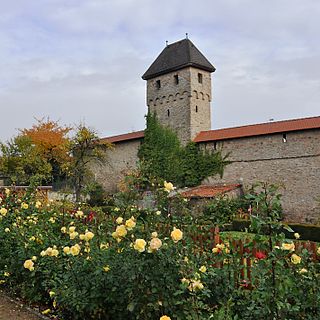
Kirchheimbolanden, the capital of Donnersbergkreis, is a town in Rhineland-Palatinate, south-western Germany. It is situated approximately 25 km west of Worms, and 30 km north-east of Kaiserslautern. The first part of the name, Kirchheim, dates back to 774. It became a town in 1368, and the Sponheim family improved its security with many towers and walls. William, Duke of Nassau, ancestor of the royal families of Belgium, Sweden, Denmark and Norway, and of the grand-ducal family of Luxembourg, was born in Kirchheimbolanden. It was also ruled by the First French Empire between 1792 and 1814, before passing to the Kingdom of Bavaria in 1815. It was a rural district centre in the Rheinkreis, which was renamed Pfalz (Palatinate) in 1835.

The term Kaiserpfalz or Königspfalz refers to a number of palaces and castles across the Holy Roman Empire that served as temporary seats of power for the Holy Roman Emperor in the Early and High Middle Ages.
Conrad II of Teck was Duke of Teck.

Rudolf I, Margrave of Baden served as Regent to Margrave Frederick I from 1250 until 1267, then as Margrave of Baden from 1268 until his death in 1288.
Ernest Casimir of Nassau-Weilburg was the founder of the younger line of Nassau-Weilburg.

Philip IV of Nassau-Weilburg, also known as Philip III of Nassau-Saarbrücken was Count of Nassau-Weilburg from 1559 until his death and since 1574 also Count of Nassau-Saarbrücken. Both possessions belonged to the Walram line of the House of Nassau. In Weilburg, he was the fourth count named Philip, but only the third in Saarbrücken, because his father, Philip III of Nassau-Weilburg never held Nassau-Saarbrücken.
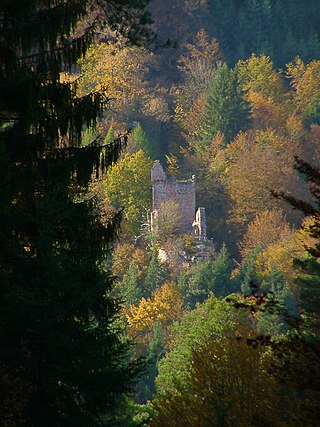
The ruins of Breitenstein Castle stand on a crag, 220 metres (720 ft) high, on the northern side of the Speyerbach valley in the Palatine Forest in Germany. The castles is 4 kilometres (2.5 mi) east of the village of Elmstein in the county of Bad Dürkheim in the state of Rhineland-Palatinate.

Guttenberg Castle is a ruined rock castle near the French border in the German part of the Wasgau, which in turn is part of the Palatine Forest in the state of Rhineland-Palatinate.

Hohenecken Castle is the ruin of a spur castle from the Hohenstaufen era on the Schlossberg hill above the Kaiserslautern ward of Hohenecken in Rhineland-Palatinate, Germany. It is located at an elevation of 363 m above sea level (NN).
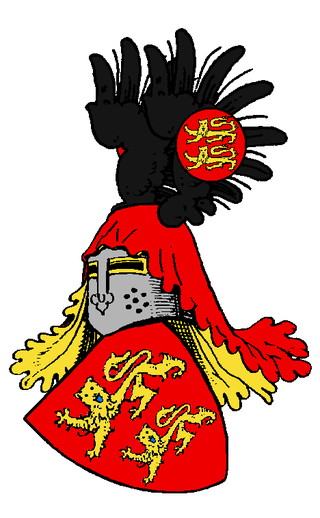
The County of Diez was a county of the Holy Roman Empire, centred around Grafenschloss in Diez, located in Lahngau. The county is first recorded in 1073, likely formed from the lands of the Conradine dynasty after their relocation to Swabia. The Counts of Diez gained prominence in the late twelfth century as strong supporters of the Hohenstaufen dynasty, earning it the nickname "Golden County."

Schauenburg Castle is a ruined hilltop castle located in Oberkirch, Germany, atop a 367-metre-high (1,204 ft) (NN) hill spur overlooking the Rench river valley above the town of Gaisbach, Baden-Württemberg. The castle was built by Duke Berthold II of Zähringen.
The Barony of Bilstein was a dynastic lordship with extensive estates in the region of the present German states of Hesse and Thuringia and a territory of the Holy Roman Empire.

The Ehrenburg is the ruin of a spur castle at 230 m above sea level (NN) in the vicinity of Brodenbach in Germany. The castle had a very eventful history. It was built on a rocky spur called the Ehrenberg situated above the valley of the Ehrbach, a right bank valley of the Moselle. Once the fortified heart of a small imperial barony with estates between the Lower Moselle and Middle Rhine, it is today a cultural monument that hosts numerous events.

Philip III of Falkenstein, Lord of Falkenstein, Münzenberg and Lich, Hesse was a member of the Lich line of the Falkenstein dynasty, son of Werner I of Falkenstein, Lord of Münzenberg and Falkenstein, who founded the Lich line, and his wife Mechtild of Diez.
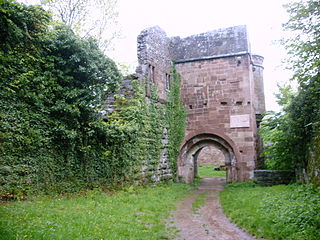
Wildenberg Castle, also called the Wildenburg, is a ruined, Hohenstaufen period castle in the Odenwald hills in Germany. It is located in the parish of Preunschen in the municipality of Kirchzell, in the Lower Franconian district of Miltenberg in Bavaria.

The Imperial Palace at Gelnhausen is located on a former island in the Kinzig river in Gelnhausen, Hesse, Germany.

Hohenfels Castle is a ruined hill castle at a height of 545 m above sea level (NHN), in the Beutelfels Nature Reserve north of the village of Imsbach in the county of Donnersbergkreis in the German state of Rhineland-Palatinate. The castle may be reached via a steep footpath from the visitor mine of Weiße Grube in the valley of Langental. The path passes the "Iron Man" monument.
Countess Mechthild of Sayn, also called Mechthild of Landsberg, Mechtild, Mechtildis or Mathilde, was the wife of Henry III of Sayn. She was an important figure in the Late Middle Ages because of her religious foundations (Stiftungen).
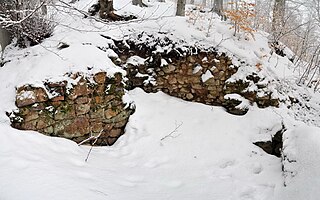
Tannenfels Castle is a ruined hill castle of the motte and bailey type which stands at a height of 460 m above sea level (NN) above the village of Dannenfels on the Donnersberg hill in the county of Donnersbergkreis in the German state of Rhineland-Palatinate.


















